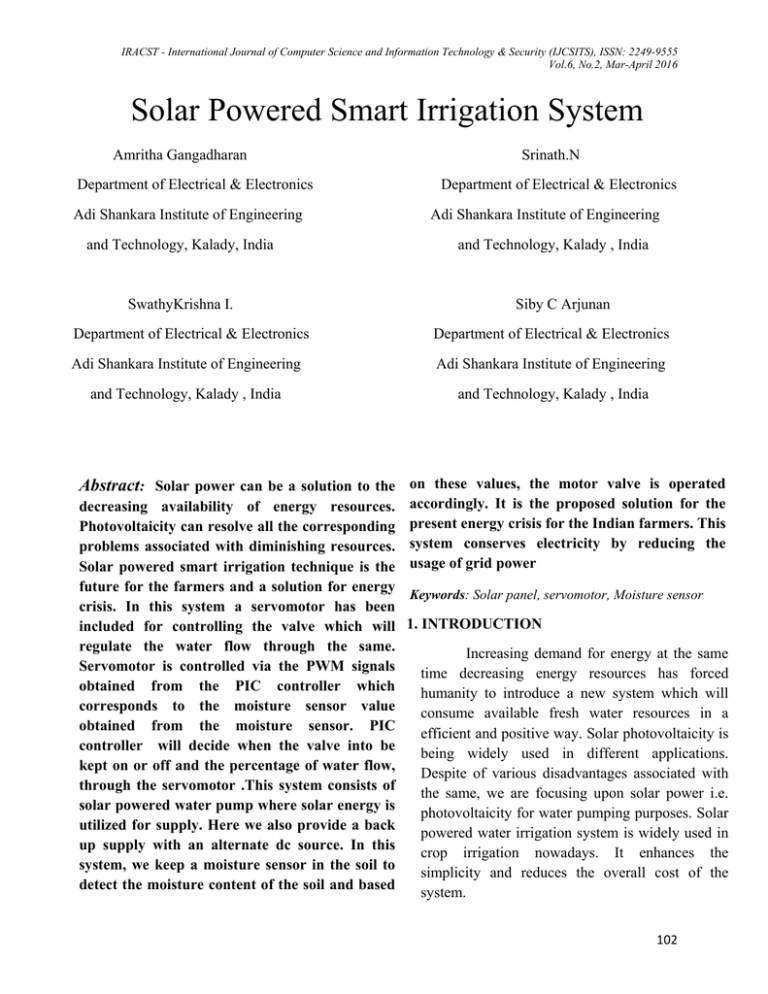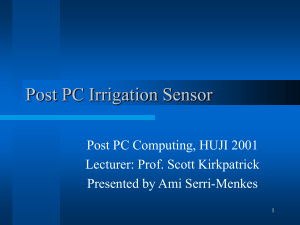Solar Powered Smart Irrigation System
advertisement

IRACST - International Journal of Computer Science and Information Technology & Security (IJCSITS), ISSN: 2249-9555 Vol.6, No.2, Mar-April 2016 Solar Powered Smart Irrigation System Amritha Gangadharan Department of Electrical & Electronics Adi Shankara Institute of Engineering and Technology, Kalady, India SwathyKrishna I. Srinath.N Department of Electrical & Electronics Adi Shankara Institute of Engineering and Technology, Kalady , India Siby C Arjunan Department of Electrical & Electronics Department of Electrical & Electronics Adi Shankara Institute of Engineering Adi Shankara Institute of Engineering and Technology, Kalady , India and Technology, Kalady , India Abstract: Solar power can be a solution to the on these values, the motor valve is operated decreasing availability of energy resources. Photovoltaicity can resolve all the corresponding problems associated with diminishing resources. Solar powered smart irrigation technique is the future for the farmers and a solution for energy crisis. In this system a servomotor has been included for controlling the valve which will regulate the water flow through the same. Servomotor is controlled via the PWM signals obtained from the PIC controller which corresponds to the moisture sensor value obtained from the moisture sensor. PIC controller will decide when the valve into be kept on or off and the percentage of water flow, through the servomotor .This system consists of solar powered water pump where solar energy is utilized for supply. Here we also provide a back up supply with an alternate dc source. In this system, we keep a moisture sensor in the soil to detect the moisture content of the soil and based accordingly. It is the proposed solution for the present energy crisis for the Indian farmers. This system conserves electricity by reducing the usage of grid power Keywords: Solar panel, servomotor, Moisture sensor 1. INTRODUCTION Increasing demand for energy at the same time decreasing energy resources has forced humanity to introduce a new system which will consume available fresh water resources in a efficient and positive way. Solar photovoltaicity is being widely used in different applications. Despite of various disadvantages associated with the same, we are focusing upon solar power i.e. photovoltaicity for water pumping purposes. Solar powered water irrigation system is widely used in crop irrigation nowadays. It enhances the simplicity and reduces the overall cost of the system. 102 IRACST - International Journal of Computer Science and Information Technology & Security (IJCSITS), ISSN: 2249-9555 Vol.6, No.2, Mar-April 2016 Smart irrigation helps the efficient use of freshwater resources in agricultural areas which very important due to highly increasing demand for freshwater, optimal usage of water resources have been provided with greater extent by automation technology. Discrete and wired solutions for irrigation purposes are very difficult while considering large geographical areas. In addition, the developing irrigation method removes the need for workmanship for flooding irrigation. Cultivation has played a major role in human societies endeavors to be self-sufficient in food. Irrigation is an essential component of crop production in many areas of the world. In cotton for example, recent studies have shown that proper timing of irrigation is an important production factor and that delaying irrigation can result in losses. The graph explains the exponential decrease of water per capita (Fig.1) [1]. Automation of irrigation system has the potential to provide maximum water use efficiency by monitoring soil moisture at optimum level. The control unit is the pivotal block of entire irrigation system. It controls the flow of water and therefore enables the grower to acquire optimized results. Greenhouses form an important part of the agriculture and horticulture sectors in our country as they can be used to grow plants under controlled climatic conditions for optimum production. Automating a greenhouse envisages monitoring and controlling of the climatic parameters which directly or indirectly govern the plant growth and hence their production [2]. India is country which focuses towards the modernization of the conventional agricultural practices for the better productivity. Due to over use of water it has lead to acute shortage of freshwater. which lead decreasing ground water. Lack of rains and scarcity of land water also results in decrement in quantity of water on earth surface [4]. The no. moisture sensor to be used is proportional to that of the field size is, therefore as the field size increases the no. of moisture sensors for moisture content sensing also increases. Fig1: The graph shows exponential decrease of water per capita. [1] 2. WORKING OF THE SYSTEM Fig 2: Block Diagram of the Proposed System The system consists of solar panel as the main power source and battery for backup 103 IRACST - International Journal of Computer Science and Information Technology & Security (IJCSITS), ISSN: 2249-9555 Vol.6, No.2, Mar-April 2016 purposes. The water is filled using a normal pipe into the storage tank. The outlet valve of the tank is mechanically controlled via a servomotor which basically works on the basis of PWM Signals received from the PIC controller. The servomotor rotates either in clockwise or anticlockwise direction as per the PWM signals at the input of the same. The PWM signals by the controller which is proportional to the moisture sensor value provided by the moisture sensor buried deep down the soil. The block diagram explains how the entire system works (Fig2). If the moisture sensor value is below the prescribed value the servomotor will run accordingly so as to open the valve proportional to the deficiency of moisture present in the soil. After the moisture value is restored, the servomotor will rotate in opposite direction to close the value. 3. FLOWCHART 4. SIMULATION Fig 4: Simulation Diagram Fig4 shows the simulation diagram of the system which basically consists of a PIC controller which gives corresponding signals to the motor on the basis of variation the potentiometer. The motor here is depicted as a servomotor and the potentiometer as the moisture sensor values. The contrast of the LCD Panel can be adjusted via a potentiometer. The LCD display displays the moisture level in %. 5. HARDWARE Fig3. Flowchart of the Proposed System Fig 5. Hardware Assembly 104 IRACST - International Journal of Computer Science and Information Technology & Security (IJCSITS), ISSN: 2249-9555 Vol.6, No.2, Mar-April 2016 Prototype is based on solar powered water irrigation system. It consists of automatic water flow control using a servomotor based on the values from a moisture sensor. The water supply valve is controlled based on these values obtained from microcontroller. The LCD Display show casts the remaining battery life.12v Battery is being introduced so as to power the system. 6. SOFTWARE MPLAB IDE V8.40 which is basically used for programming purposes of PIC and dsPIC and is developed by Microchip technology. In this corresponding prototype we have used the same software for programming of the PIC microcontroller 16F873A. 8. FUTURE SCOPE Prototype can be improvised by adding a Webscaper which can predict the weather and water the plants/crops accordingly. If rain is forecasted, less water is let out for the plants. Also, a GSM module can be included so that the user can control the system via smart phone. A water meter can be installed to estimate the amount of water used for irrigation and thus giving cost estimation. A solenoid valve can be used for varying the volume of water flow. Furthermore, Wireless sensors can also be used. Solar tracker using LDR for efficient working of the system which will enable the solar panel to automatically get placed itself in the appropriate path where the solar energy is maximum. 7. CONCLUSION By implementing the proposed system there are various benefits for the government and the farmers. For the government a solution for energy crisis is proposed. By using the automatic irrigation system it optimizes the usage of water by reducing wastage and reduces the human intervention for farmers. The excess energy produced using solar panels can also be given to the grid with small modifications in the system circuit, which can be a source of the revenue of the farmer, thus encouraging farming in India and same time giving a solution for energy crisis. Proposed system is easy to implement and environment friendly solution for irrigating fields. The system was found to be successful when implemented for bore holes as they pump over the whole day. Solar pumps also offer clean solutions with no danger of borehole contamination. The system requires minimal maintenance and attention as they are self starting. To further enhance the daily pumping rates tracking arrays can be implemented. 9. REFERENCES [1] Mahir DURSUN and Semih OZDEN “Application of Solar Powered Automatic Water Pumping “ , International Journal of Computer and Electrical Engineering, Vol.4, No.2, April 2012. [2] Mr. S.G. Galande, Dr. G.H. Agrawal ”Embedded Controlled Drip Irrigation System “, International Journal of Emerging Trends & Technology in Computer Science , Volume 2, Issue 5, September – October 2013 [3] S. Darshna, T.Sangavi , Sheena Mohan , A.Soundharya , Sukanya Desikan “,IOSR Journal of Electronics and Communication Engineering (IOSR-JECE) e-ISSN: 22782834,p- ISSN: 2278-8735”,Volume 10, Issue 3, Ver. II [4] Prashant S. Patil , Shubham R. Alai , Ashish C. Malpure , Prashant L.Patil “, An Intelligent and Automated Drip Irrigation System Using Sensors Network Control System “, International Journal of Innovative Research in Computer and Communication Engineering Vol. 2, Issue 12, December 2014 [5] S. Harishankar ,R. Sathish Kumar, Sudharsan K.P, U. Vignesh and T.Viveknath”, Advance in Electronic and Electric Engineering.ISSN 2231-1297”, Volume 4, Number 4 (2014). 105 IRACST - International Journal of Computer Science and Information Technology & Security (IJCSITS), ISSN: 2249-9555 Vol.6, No.2, Mar-April 2016 10. AUTHORS’S PROFILE Amritha Gangadharan was born in 1994 and is a Undergraduate student pursuing Electrical and Electronics Engineering from Adi Shankara Institute of Engineering and Technology, Kalady Ernakulam. Srinath.N was born in 1994 and is a Undergraduate student pursuing Electrical and Electronics Engineering from Adi Shankara Institute of Engineering and Technology, Kalady Ernakulam. SwathyKrishna.I was born in 1994 and is a Undergraduate student pursuing Electrical and Electronics Engineering from Adi Shankara Institute of Engineering and Technology, Kalady Ernakulam. Siby C Arjunan received B.Tech degree in Electrical and electronics engineering from Mar Athanasius College of Engineering Kothamangalam, Mahatma Gandhi University ,Kottayam, Kerala, INDIA in 2009 and M.Tech in Control Systems from College Of Engineering Trivandrum in 2011.Currently she is an Assistant Professor of Electrical and Electronics Engineering Department of Adi Shankara College of Engineering and Technology Kalady. Her area of interest is Control Systems 106



